Many of us spend a significant portion of our lives sitting at desks, staring at computer screens, and attending to the demands of our digital workstations. While this sedentary lifestyle is often associated with convenience and productivity, it comes with a hidden price tag: Sciatica.
This crippling illness is growing more and more common in office workers. The pain makes it hard for you to relax and focus on your task overall, affecting your productivity. But this can be avoided using the right ergo and comfortable chair.
One of the best office chairs for sciatica can provide essential support to your lower back and pelvis, helping to alleviate pain and enhance your concentration during the day.

The idea of writing a blog on this topic came to my mind when I started recovering from my sciatica pain. As a sciatica patient, I had to long suffer with switching chairs to get the right one. However, with the help of my doctors, I was able to get clear on what a perfect sciatica chair should feel like and I managed to make a list of the best sciatica office chairs.
Continue reading to benefit from my experience!
The best sciatica office chairs (at a glance)
- Herman Miller Embody Ergonomic Office Chair (Premium and Overall Best Chair)
- Steelcase Gesture Office Chair (Best Durable)
- GABRYLLY Ergonomic Mesh Office Chair – (Best Posture Friendly)
- Herman Miller Aeron Ergonomic Chair (Best Comfortable)
- HON Nucleus Recharged White Office Chair (Best Lumbar Support)
- Duramont Ergonomic Office Chair (Best Adjustable)
- Zuerst Ergonomic Office Chair (Best Lightweight)
- Modway EEI-757-BLK Articulate Ergonomic Mesh Office Chair (Best Material)
Understanding the role of Ergonomics in the treatment of Sciatica
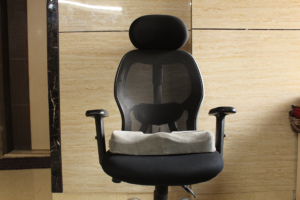
Ergonomic design isn’t just a buzzword; it’s a game-changer and most important for you to realize and understand this.
It’s all about crafting chairs that cradle your spine’s natural curves, champion impeccable posture, and banish bodily strain from your workday.
So, what should you be on the lookout for?
Seek chairs equipped with adjustable heights, lumbar-loving support, and armrests that play nicely with your body’s demands. These nifty tweaks transform your chair into a personalized haven of support and alignment and help to treat sciatica.
My best experience was with the ones that offer a “waterfall” seat edge, rescuing your thighs from undue pressure. Plus, they’re clad in breathable materials for an all-day comfort extravaganza.
Top 8 Best Office Chairs for Sciatica Reviewed
1. Herman Miller Embody Ergonomic Office Chair: Premium and Overall Best Chair
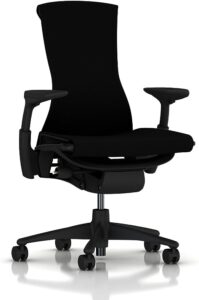
If you are looking for something sturdy yet soft, the HM embody is the best pick for you. My colleague introduced this one to our office; honestly speaking, It was the best decision ever.
A powerhouse team of over 20 brilliant minds, including physicians and PhDs specializing in biomechanics, vision, physical therapy, and ergonomics, came together to craft this extraordinary chair. I liked its adjustable backrest, which aims for a neutral, balanced posture.
This one has set a new benchmark for pressure distribution, natural alignment, and support for healthy movement in ergonomic seating so if you are someone who sticks to your traditional office chair once you reach your workplace, you need to think about this.
Likes
- Pixelated adjustability made back support a delightful experience for me.
- This office chair’s 4-layer comfort and support strike a perfect balance, combining ergonomics, style, and durability like never before.
Dislikes
- The lower back of the chair is not adjustable and I felt trouble while leaning back.
2. Steelcase Gesture Office Chair: Best Durable pick
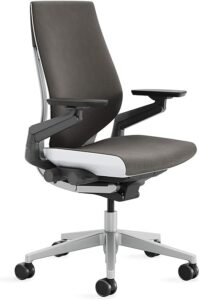
My pick, which I use in my home office, is the Steelcase gesture chair. This helps wonders for sciatica pain. It features adjustable seat depth, arms, pneumatic seat height, recline tension adjustment, a 4-position recline lock, shell back, and seat.
The fabric is 100% polyester, one of my reasons to invest in it. The fabric is specially designed to avoid sweating at the back and keep the person focused comfortably on the task.
Likes
- The armrests on this chair are impressively sturdy, no matter how you adjust them.
- Can tilt back VERY far compared to traditional office chair.
Dislikes
- It’s quite on the heavy side.
3. GABRYLLY Ergonomic Mesh Office Chair: Best Posture Friendly
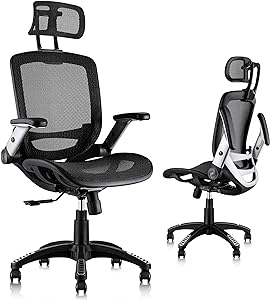
Herniated disc pain can be painful and distract your attention from every other work. But the GABRYLLY Office Chair is the cure to all your woes.
This chair is designed with ergonomics in mind, offering support to your lower back (lumbar region) and Certainly promotes a good posture. The contoured mesh backrest was my favorite part. It is meant to provide proper spinal alignment. I found the cushioned seat carefully crafted to provide support while remaining comfortable for extended periods.
Likes
- Mesh back and mesh seat keep air circulation for extra comfort
- The PU mute wheels on this chair roll like a dream
- It can accommodate different body builds
Dislikes
- If you’re under 5’5, it might cause discomfort
4. Herman Miller Aeron Ergonomic Chair: Best Comfortable
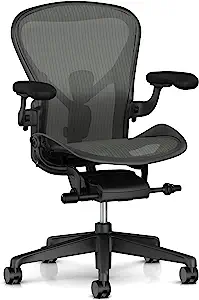
The HM Aeron might not be my first choice, but the wonders this chair offers are truly unmatched. The Aeron chair boasts a unique and instantly recognizable design. Its mesh backrest and seat look sleek and provide excellent breathability, ensuring you stay cool even during extended work sessions. Especially when you’re up for overtime.
The ergonomic design conforms to the natural curve of your spine, offering exceptional lumbar support. You can fine-tune the seat height, armrest height and angle, lumbar support, and tilt tension to suit your body and work style.
Likes
- The back support is a game-changer, and I can finally sit comfortably for extended periods.
- It’s durable and reliable, so no need to worry about replacing it for next many years.
Dislikes
- I found the assembly somewhat complicated.
- The chair doesn’t accommodate heavier weight.
5. HON Nucleus Recharged: Best Lumbar Support
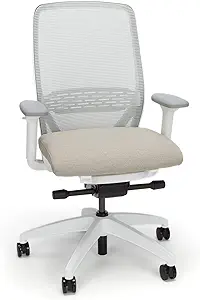
HON is known for producing durable office furniture, and the Nucleus Recharged chair is no exception. It’s designed to withstand the demands of daily office use. What I liked most about it that not only is it pleasing to the eyes but also offers extreme lumbar support that keeps you comfortable in extended periods of sitting.
Its deep cushion ergonomic features pressure-mapped seat contours to reduce pressure points and dynamic 4-way stretch mesh that flexes in every direction for support of up to 300 lbs.
Likes
- The 360 swivel feature adds a new level of convenience and freedom to my workspace.
- The Stain-repellent technology is a total lifesaver.
- The multi-position tilt-lock lets me fine-tune my comfort, whether working, reading, or relaxing.
Dislikes
- If you’re on a budget, this might be pricey.
6. Duramont Ergonomic Office Chair: Best Adjustable
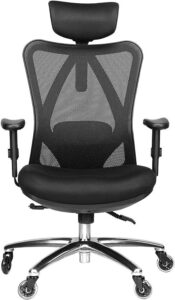
Have back issues or don’t want to develop them? This unique office chair includes adjustable lumbar support that goes in and out, up and down, and a recline feature that allows you to tilt the backrest back or sit straight. It has a weight capacity of 330 LBS.
Unlike other office chairs, the Duramont chair offers a SECOND adjustment lever that allows you to lock in your desired recline angle at any degree. That way, you can be assured of finding the perfect comfortable seating position just for you. This was just the right buddy for overtime or night-stay projects.
Likes
- Simple instructions enable anyone to assemble the chair in eight simple steps!
- Rollerblade caster wheels help me move around easily.
Dislikes
- This chair is objectively heavy but supports various sizes.
7. ZUERST Ergonomic Office Chair: Best Lightweight
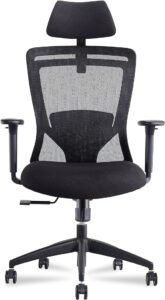
4D Lumbar Support, 5D Headrest, 3D Armrest, Seat Height, Recline Function, and 360 rotative wheels are what make up the ZUERST office chair.
It’s solid and sturdy yet not so heavy. The chair is extremely comfortable and sits perfectly for people up to 6 ft in height. The rocking mechanism and headrest are great for anyone with back or neck problems. I’m quite a nitpicker when it comes to my comfort but I was surely satisfied with this chair.
Likes
- Adjustable headrest provides customizable support and comfort.
- It’s lightweight yet incredibly sturdy, striking the perfect balance between portability and durability.
Dislikes
- The rail for the footrest lines up with the chair height lever which made it hard to bring out the footrest without hitting the lever.
8. Modway EEI-757-BLK: Best material
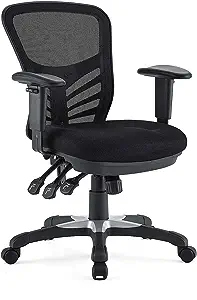
Articulate doesn’t just provide ergonomic support, it’s your go-to chair for dependable comfort. With its breathable mesh back, built-in lumbar support, and a generously cushioned 6-inch thick mesh seat, it’s designed to keep you feeling fresh and well-supported throughout your workday.
It is a computer chair designed to easily adjust to your needs with height adjustable armrests, one-touch chair height adjustment, 360-degree swivel, and a tilt and lock system.
Likes
- Five dual-wheel casters, I love how stable and smooth they feel.
- With the tilt and lock system, I can easily lean back to my fav angles.
- It easily holds up to 331 Lbs.
Dislikes
- It becomes squeaky after some time.
Can Your Office Chair Cause You to Have Sciatica?

While working overtime or on long projects in your office, You remain in the same position of sitting for a long period, and that causes you to slump, stretch, and maintain a very bad posture.
I know this very well as I was experiencing excruciating pain and burning sensations in my hip and lower back in my work life. That’s when I learned about sciatica and tried taking measures to cure my misery. My best experience was with the Steel Case Gesture Office Chair; not only did it help with the pain, but also I started enjoying my work life.
So, yes, your office chair can contribute to the development or exacerbation of sciatica, particularly if it lacks proper ergonomic features and support. Here’s how:
– Poor Posture
Prolonged sitting in a chair that doesn’t support good posture can put excessive pressure on your lower back and compress the sciatic nerve. This pressure can lead to irritation and inflammation of the nerve, contributing to sciatica.
– Lack of Lumbar Support
Chairs without adequate lumbar support fail to maintain the natural curve of your lower spine. This can strain the lower back and increase the risk of sciatic pain.
– Inadequate Seat Cushioning
Chairs with insufficient cushioning can lead to discomfort and increased pressure on the buttocks and thighs. This discomfort may indirectly affect your posture and potentially worsen sciatica symptoms.
– Non-Adjustable Features
Traditional office chairs that don’t allow for height and tilt adjustments can force you into awkward seating positions, increasing the risk of sciatic nerve compression.
– Lack of Armrests
Without armrests, you may place additional strain on your upper body, causing you to shift your weight and posture in a way that can contribute to sciatic discomfort.
To minimize the risk of sciatica or alleviate its symptoms, it’s essential to invest in an office chair that promotes proper posture and offers ergonomic support. Look for chairs with adjustable features, lumbar support, cushioned seats, and appropriate dimensions to ensure a comfortable and spine-friendly sitting experience.
Speaking from experience, taking regular breaks to stretch and move can also help prevent sciatica from developing or worsening due to prolonged sitting.
Things to consider when buying a chair for Sciatica
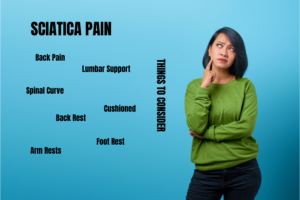
Shopping for office chairs when dealing with sciatica requires thoughtful consideration to ensure comfort and relief during long hours at your desk. Your back hurts already and what if you buy a pricey chair as a cure but it doesn’t meet your requirements?
Well, to keep you from going through all that hassle, Here’s a comprehensive purchasing guide highlighting key factors to keep in mind.
- Ergonomic Design: Look for chairs designed with ergonomics in mind. These chairs are crafted to support the natural curvature of your spine, promoting proper posture and reducing pressure on the sciatic nerve.
- Lumbar Support: Opt for chairs that offer adjustable lumbar support. Proper lumbar support is crucial for alleviating sciatic pain and maintaining a healthy back posture.
- Seat Cushioning: Check for generously padded seats with appropriate cushioning. A comfortable seat with adequate padding can help distribute your weight evenly and reduce pressure on your lower back and hips.
- Adjustability: Ensure the chair offers various adjustments, such as seat height, backrest tilt, and armrest height. These features allow you to customize the chair to your body’s needs, minimizing the risk of aggravating sciatic pain.
- Seat Depth: Consider chairs with adjustable seat depth. The ability to fine-tune the seat depth ensures your thighs are adequately supported without putting undue pressure on the back of your knees.
- Material and Breathability: Choose chairs with breathable materials, like mesh or fabric, to prevent overheating during extended periods of sitting. Proper airflow can enhance overall comfort.
- Weight Capacity: Verify that the chair’s weight capacity accommodates your body type. A chair with a suitable weight limit ensures stability and durability.
- Swivel and Mobility: Chairs with swivel and smooth-rolling casters allow you to move effortlessly, reducing the need for excessive twisting or reaching, which can strain your back.
- Budget: Set a budget that aligns with your requirements. While high-quality ergonomic chairs can be an investment, they are often worth it for their long-term comfort and health benefits.
- User Reviews: Read user reviews and testimonials to gain insights into real-world experiences with the chair you’re considering. Pay attention to feedback from individuals with similar sciatica concerns.
- Warranty: Check the chair’s warranty to ensure you’re covered in case of any manufacturing defects or issues.
- Try Before Buy: If possible, test the chair in person to assess its comfort and adjustability. This step can help you find the best fit for your specific needs.
By considering these factors, you can make an informed decision when purchasing an office chair that will provide the necessary support and comfort to relieve and prevent sciatica discomfort.
Related Read: Are kneeling chairs good for sciatica?
Conclusion
Finding the right office chair for sciatica can make a difference in your daily work life. Sciatica, with its painful symptoms, demands thoughtful consideration when choosing the right chair to provide comfort and support.
Considering these factors, I tried to look into some specific features in all best-selling chairs closely and attempted to pick out some best of the bests.
Hope this helped.
FAQ’s
How should I sit at my desk with sciatica?
When sitting at your desk with sciatica, follow these tips:
- Use an ergonomic chair with proper lumbar support.
- Sit back with your feet flat on the floor and knees at a 90-degree angle.
- Maintain good posture with your back straight.
- Take frequent breaks to stand, stretch, and walk to prevent prolonged sitting.
- Consider using a cushion or lumbar roll for additional support
What kind of chair is best for sciatica?
The best chair for sciatica is an ergonomic chair that provides proper lumbar support, adjustable features, and comfortable cushioning. It should promote a good posture and reduce pressure on the sciatic nerve. And most of all, keep you comfortable throughout your day.
Can a bad office chair cause sciatica?
YES, Without a firm chair, you’re bound to slouch and mess up your posture. It also puts pressure on the sciatic nerve, which can cause inflammation and irritation of the nerve, leading to sciatic pain. It’s always a better choice to have an ergonomic chair to avoid problems.
Do ergonomic chairs help with sciatica?
Yes, ergonomic chairs can help with sciatica by providing proper lumbar support, promoting good posture, and reducing pressure on the sciatic nerve, which can alleviate discomfort and prevent exacerbation of symptoms.
Adam had a bad experience with his 5 years of job life. He later decided to start his own initiatives and now pursuing his passion for years. Working as a founder and senior editor at Workplace Ambitions is like a dream come true – sharing stuff related to the things he faced earlier and helping the community achieve their work-life dreams. Reach out to him at Adam@workplaceambitions.com.
